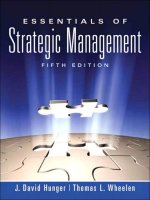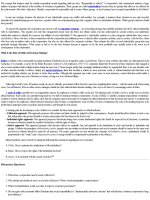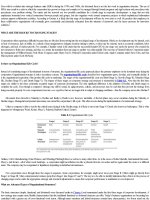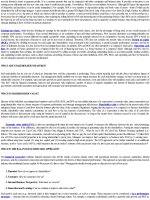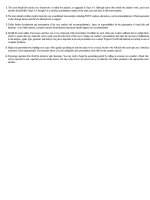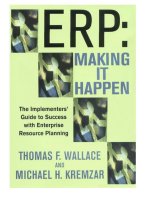Essentials of Strategic Management 5th Edition_1 ppt
Bạn đang xem bản rút gọn của tài liệu. Xem và tải ngay bản đầy đủ của tài liệu tại đây (223.13 KB, 18 trang )
ESSENTIALS OF STRATEGIC MANAGEMENT
Fifth Edition
ESSENTIALS OF STRATEGIC MANAGEMENT
J. David Hunger
Saint John’s University
Iowa State University
Thomas L. Wheelen
Formerly with University of Virginia
Trinity College, Dublin, Ireland
Editorial Director: Sally Yagan
Editor in Chief: Eric Svendsen
Acquisitions Editor: Kim Norbuta
Director of Editorial Services: Ashley Santora
Editorial Project Manager: Claudia Fernandes
Editorial Assistant: Meg O’Rourke
Director of Marketing: Patrice Lumumba Jones
Marketing Manager: Nikki Ayana Jones
Marketing Assistant: Ian Gold
Senior Managing Editor: Judy Leale
Production Project Manager: Debbie Ryan
Operations Specialist: Clara Bartunek
Creative Art Director: Jayne Conte
Cover Designer: Bruce Kenselaar
Manager, Visual Research: Beth Brenzel
Manager, Rights and Permissions: Shannon Barbe
Image Permission Coordinator: Christie Barros
Manager, Cover Visual Research & Permissions: Karen Sanatar
Cover Art: Fotolia
Full-Service Project Management: Sadagoban Balaji/Integra Software Services, Ltd.
Composition: Integra Software Services, Ltd.
Printer/Binder: R R Donnelley/Harrisonburg
Cover Printer: R R Donnelley/Harrisonburg
Text Font: 10/12 Palatino
Credits and acknowledgments borrowed from other sources and reproduced, with permission, in this textbook appear on appropriate page within text.
Copyright © 2011, 2007, 2003, 2001 by Pearson Education, Inc., publishing as Prentice Hall, One Lake Street, Upper Saddle River, New Jersey 07458.
All rights reserved. Manufactured in the United States of America. This publication is protected by Copyright, and permission should be obtained from the publisher
prior to any prohibited reproduction, storage in a retrieval system, or transmission in any form or by any means, electronic, mechanical, photocopying, recording, or
likewise. To obtain permission(s) to use material from this work, please submit a written request to Pearson Education, Inc., Permissions Department, One Lake Street,
Upper Saddle River, New Jersey 07458.
Many of the designations by manufacturers and seller to distinguish their products are claimed as trademarks. Where those designations appear in this book, and the
publisher was aware of a trademark claim, the designations have been printed in initial caps or all caps.
Library of Congress Cataloging-in-Publication Data
Hunger, J. David
Essentials of strategic management / J. David Hunger, Thomas L. Wheelen 5th ed.
p. cm.
Includes bibliographical references and index.
ISBN-13: 978-0-13-600669-5 (alk. paper)
ISBN-10: 0-13-600669-8 (alk. paper)
1. Strategic planning. 2. CASE method. I. Wheelen, Thomas L. II. Title.
HD30.28.H867 2010
658.4'012—dc22
2010007380
10 9 8 7 6 5 4 3 2 1
www.pearsonhighered.com
ISBN 10: 0-13-600669-8
ISBN 13: 978-0-13-600669-5
Dedicated To
Kathy, Richard, & Tom
Betty, Kari & Jeff, Suzi & Nick, Lori & Dave, Merry & Dylan; Maddie & Meggie, Summer & Kacey; and Wolfie the dog
BRIEF CONTENTS
PART I Introduction to Strategic Management
Chapter 1 Basic Concepts of Strategic Management
Chapter 2 Corporate Governance and Social Responsibility
PART II Scanning the Environment
Chapter 3 Environmental Scanning and Industry Analysis
Chapter 4 Internal Scanning: Organizational Analysis
PART III Strategy Formulation
Chapter 5 Strategy Formulation: Situation Analysis and Business Strategy
Chapter 6 Strategy Formulation: Corporate Strategy
Chapter 7 Strategy Formulation: Functional Strategy and Strategic Choice
PART IV Strategy Implementation and Control
Chapter 8 Strategy Implementation: Organizing for Action
Chapter 9 Strategy Implementation: Staffing and Leading
Chapter 10 Evaluation and Control
PART V Introduction to Case Analysis
Chapter 11 Suggestions for Case Analysis
Appendix 11.A Suggested Techniques for Case Analysis and Presentation
Appendix 11.B Resources for Case Research
Appendix 11.C Strategic Audit of a Corporation
Preface xiii
Part I Introduction to Strategic Management
Chapter 1 Basic Concepts of Strategic Management
1.1 The Study of Strategic Management
1.2 Initiation of Strategy: Triggering Events
1.3 Basic Model of Strategic Management
1.4 Strategic Decision Making
Discussion Questions
Key Terms
Notes
Chapter 2 Corporate Governance and Social Responsibility
2.1 Corporate Governance: Role of the Board of Directors
2.2 Corporate Governance: Role of Top Management
2.3 Social Responsibilities and Ethics in Strategic Decision Making
Discussion Questions
Key Terms
Notes
Part II Scanning the Environment
Chapter 3 Environmental Scanning and Industry Analysis
3.1 Environmental Scanning
3.2 Industry Analysis: Analyzing the Task Environment
3.3 Competitive Intelligence
3.4 Forecasting
3.5 Synthesis of External Factors—EFAS
Discussion Questions
Key Terms
Notes
Chapter 4 Internal Scanning: Organizational Analysis
4.1 Resource-Based View of the Firm
4.2 Business Models
4.3 Value-Chain Analysis
4.4 Scanning Internal Resources and Capabilities
4.5 Synthesis of Internal Factors—IFAS
Discussion Questions
Key Terms
Notes
Part III Strategy Formulation
Chapter 5 Strategy Formulation: Situation Analysis and Business Strategy
5.1 Situational (SWOT) Analysis
5.2 Review of Mission and Objectives
5.3 Generating Alternative Strategies Using a TOWS Matrix
5.4 Business Strategies
Discussion Questions
Key Terms
Notes
Chapter 6 Strategy Formulation: Corporate Strategy
6.1 Corporate Strategy
6.2 Directional Strategy
6.3 Portfolio Analysis
6.4 Corporate Parenting
Discussion Questions
Key Terms
Notes
Chapter 7 Strategy Formulation: Functional Strategy and Strategic Choice
7.1 Functional Strategy
7.2 The Sourcing Decision: Location of Functions and Capabilities
7.3 Strategies to Avoid
7.4 Strategic Choice: Selection of the Best Strategy
7.5 Development of Policies
Discussion Questions
Key Terms
Notes
Part IV Strategy Implementation and Control
Chapter 8 Strategy Implementation: Organizing for Action
8.1 What Is Strategy Implementation?
8.2 Who Implements Strategy?
8.3 What Must Be Done?
8.4 How Is Strategy to be Implemented? Organizing for Action
8.5 International Issues in Strategy Implementation
Discussion Questions
Key Terms
Notes
Chapter 9 Strategy Implementation: Staffing and Leading
9.1 Staffing
9.2 Leading
Discussion Questions
Key Terms
Notes
Chapter 10 Evaluation and Control
10.1 Evaluation and Control in Strategic Management
10.2 Measuring Performance
10.3 Strategic Information Systems
10.4 Guidelines for Proper Control
10.5 Strategic Incentive Management
Discussion Questions
Key Terms
Notes
Part V Introduction to Case Analysis
Chapter 11 Suggestions for Case Analysis
11.1 The Case Method
11.2 Frameworks for Case Analysis
11.3 Researching the Case Situation
11.4 Financial Analysis: A Place to Begin
11.5 Using the Strategic Audit in Case Analysis
Discussion Questions
Key Terms
Notes
Appendix 11.A Suggested Techniques for Case Analysis and Presentation
A. Case Analysis
B. Written Report
C. Oral Presentation by Teams
Appendix 11.B Resources for Case Research
A. Company Information
B. Economic Information
C. Industry Information
D. Directory and Index Information on Companies and Industries
E. Ratio Analysis Information
F. Online Information
Appendix 11.C Strategic Audit of a Corporation
I. Current Situation
II. Corporate Governance
III. External Environment: Opportunities and Threats
IV. Internal Environment: Strengths and Weaknesses
V. Analysis of Strategic Factors (SWOT)
VI. Strategic Alternatives and Recommended Strategy
VII. Implementation
VIII. Evaluation and Control
Index
We wrote this book to provide you with a short, concise explanation of the most important concepts and techniques in strategic management. There is no fluff in this
book. Essentials of Strategic Management is significantly shorter than our other books, but we have not “dumbed it down” or made it “cutesy.” It is a rigorous
explanation of many topics and concerns in strategic management. We condensed the content of the field into eleven carefully crafted chapters. The key concepts and
techniques are here. We cite only enough examples to help you understand the material. Although the content is based on rigorous research studies, we don’t report
every study and we don’t provide endless footnotes. Our goal was to keep the length of this book under 200 pages so that it could be easily affordable by all. For those
who want more research detail and illustrative examples, please see our other textbook, Strategic Management and Business Policy.
WHAT’S NEW IN THIS EDITION
The fifth edition of Essentials of Strategic Management contains many new content topics plus updated data and illustrations. Older examples have been replaced
with newer ones, information has been updated where appropriate, and a few errors have been corrected. In addition, the following content topics have been added to
the book:
• Added the natural physical environment to the discussion of the societal and task environments in Chapters 1 and 3.
• Contrasted agency theory with stewardship theory in the section on corporate governance in Chapter 2.
• Added paragraphs on sustainability and moral relativism plus information on enterprise strategy and social capital to the section on social responsibilities and
ethics in Chapter 2.
• Added PESTEL analysis to environmental scanning in Chapter 3.
• Added a discussion of brands to marketing resources in Chapter 4.
• Replaced the section on advantages and limitations of portfolio analysis with a section on strategic alliance portfolio analysis in Chapter 6.
• Added open innovation to the discussion of R&D strategy.
• Added purchasing and logistics strategies to functional strategies in Chapter 7.
• Included offshoring in the discussion of outsourcing in Chapter 7.
• Added real options to the discussion of risk in Chapter 7.
• Included the concept of core rigidities in the discussion of the organizational life cycle in Chapter 8.
• Added an explanation of integration managers to managing mergers and acquisitions in Chapter 9.
TIME-TESTED FEATURES
The fifth edition of Essentials of Strategic Management contains many of the same features that made previous editions successful. Some of these features are the
following:
• A strategic decision-making model based on the underlying processes of environmental scanning, strategy formulation, strategy implementation, and evaluation
and control is presented in Chapter 1 and provides an integrating framework for the book.
• Michael Porter’s approach to industry analysis and competitive strategy (plus competitive tactics!) is highlighted in Chapters 3 and 5. Hypercompetition and
cooperative strategies, such as strategic alliances, are also discussed.
• The resource-based view of the firm (including Barney’s VRIO framework), in Chapter 4, serves as a foundation for organizational analysis. Sections on
business models and value-chain analysis are also used to assess a company’s strengths and weaknesses and to identify core and distinctive competencies.
• Functional analysis and functional strategies receive major attention in Chapters 4 and 7. Sections on R&D and R&D strategies emphasize the importance of
technology to strategy and product-market decisions.
• Strategy implementation deals not only with organization design and structure, but also with executive leadership and succession, reengineering, Six Sigma, TQM,
MBO, and action planning in Chapters 8 and 9.
• Chapter 10, on evaluation and control. explains the importance of measurement and incentives to organizational performance. Benchmarking and economic
value-added measures are highlighted.
• International considerations are included in all chapters and are highlighted in special sections in Chapters 3, 6, 8, 9, and 10.
• Environmental scanning and forecasting is given an emphasis equal to that given to industry analysis in Chapter 3.
• Suggested EFAS and IFAS Tables and a SFAS Matrix in Chapters 3, 4, and 5 enable the reader to better identify and evaluate strategic factors.
• Top management and the board of directors are examined in detail as strategic managers in Chapter 2.
• Social responsibility and ethics are discussed in Chapter 2 in terms of their importance to strategic decision making.
• To aid in in-depth case analysis, a complete listing of financial ratios, recommendations for oral and written analysis, and ideas for further research are presented
in Chapter 11. The strategic audit is proposed as an aid to case analysis. This chapter is most useful for those who wish to supplement this book with cases.
• Each chapter begins with a brief situation vignette of an actual company that helps illustrate the chapter content.
• Each chapter ends with a list of key terms (which are also boldfaced within the text) and a set of discussion questions.
SUPPLEMENTS
Supplements are available for adopting instructors to download at www.pearsonhighered.com/irc, Registration is simple and gives the instructor immediate access to
new titles and new editions. Pearson’s dedicated technical support team is ready to help instructors with the media supplements that accompany this text. The instructor
should visit for answers to frequently asked questions and for toll-free user support phone numbers. Supplements include the following:
• Instructor’s Manual with Test Bank—An instructor’s manual has been carefully constructed to accompany this book. It includes a summary of the most
important concepts of each chapter, answers to discussion questions, a series of multiple-choice questions, and a set of additional discussion/essay questions for
use in exams.
• PowerPoint Slides—The PowerPoint slides highlight text learning objectives and key topics and serve as an excellent aid for classroom presentations and
lectures.
COURSESMART
CourseSmart textbooks online is an exciting new choice for students trying to economize. As an alternative to purchasing the print textbook, students can subscribe to
the same content online and save up to 50 percent off the suggested list price of the print version. With a CourseSmart e-textbook, students can search the text, make
notes online, print out reading assignments that incorporate lecture notes, and bookmark important passages for later review. For additional information on this option,
visit www.coursesmart.com.
ACKNOWLEDGMENTS
We thank Kim Norbuta, Editor, and Claudia Fernandes, Project Manager, at Prentice Hall, who supervised this edition. Without their support and encouragement, this
edition would never have been written. We are very grateful to Clara Bartunek and Sadagoban Balaji (Integra Software Services) for their patience, expertise, and even
disposition during the copyediting and production process. We also thank Betty Hunger for her work in preparing the index.
In addition, we express our appreciation to Wendy Klepetar, Management Department Chair of Saint John’s University/College of Saint Benedict, for her support
of this endeavor. Both of us thank Mary Clare McEwing and Michael Payne of Addison Wesley Publishing Company for their help in developing the first edition of this
book. We remember how hard it was to get an essentials book approved since there was no such book in print in the strategy area at that time!
Finally, to the many strategy instructors and students who have moaned to us about the increasing size and cost of textbooks: We have tried to respond to your
concerns as best we could by providing a comprehensive yet usable text that is half the size and cost of other books on the market. Instead of the usual five-course meal
(complete with heartburn), we are offering you “lean cuisine.” This book should taste good with fewer empty calories. Enjoy!
J. David Hunger
Thomas L. Wheelen
